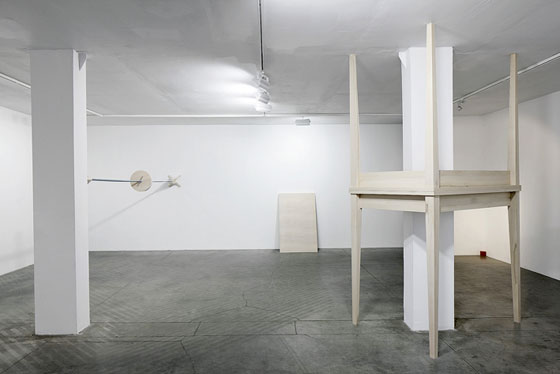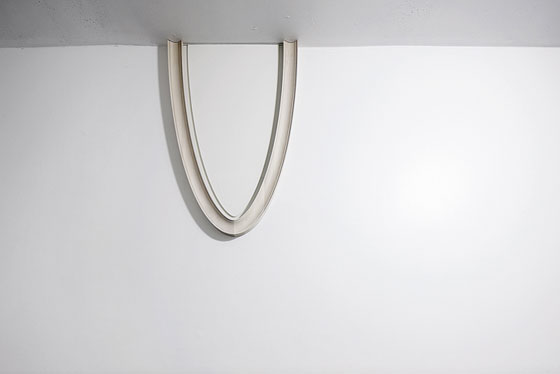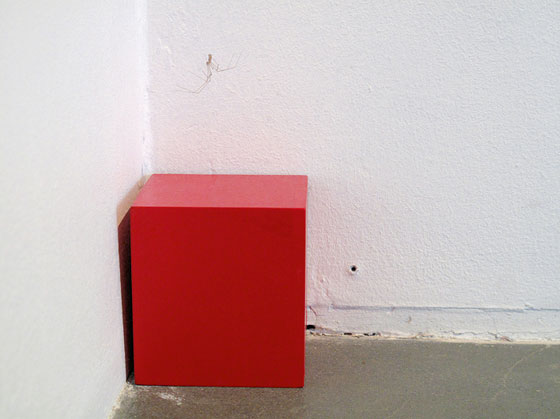|
|
| A chair is still a chair, even when there’s no-one sitting there(1) Laine Kristberga, Film and Art Historian Armands Zelčs. That Is Not Which Is. The Name of That Is Known 24.09.–30.10.2011. kim? Contemporary Art Cente | |
| In thinking about the relationship between bodies and space, Martin Heidegger once considered such an everyday expression as “the chair is touching the wall”. In his essay ‘Being and Time’ (1927) Heidegger states that “in principle the chair can never touch the wall, even if the space between them should equal to zero”.(2) At the basis of this proposition is the definition of limit, because, in accordance with Heidegger, “the limit marks the beginning of a thing, not its end”,(3) and from this perspective the relationship between things and the rest of the world should be analysed. Yet, when attending Armands Zelčs’ solo exhibition That Is Not Which Is. The Name of That Is Known. at the contemporary art centre kim?, a viewer can make sure that the chair is not only touching the wall. More so – the chair is attached to the wall by screws and as a vector parallel to the plane of the floor stretches forward to meet an identical chair – the opposite vector – at midpoint. The chair installation is complemented with two identical tables, however the tables are likewise non-functional objects. Firstly, nothing can be placed onto them, because one table is turned upside-down and is placed on top of the other. Besides, the horizontal planes of the tables are missing and they have been substituted by a dividing column of the gallery. And, secondly, the scale of the tables considerably exceeds the human scale. There are also fragments of an ellipse in the room, with one end getting lost in the ceiling and the other meeting the floor, as well as a paralellepiped [a three-dimensional figure formed by parallelograms] connecting the wall with the floor. At some point the peripheral vision registers a tiny red cube in one of the white corners of the gallery space. Still, what a viewer should regard with special attention is the connection areas or points of contact between the objects, because this is where, in conformity with the core idea underlying the exhibition, lies and reality, truth and illusion meet. | |
 Armands Zelčs. That Is Not Which Is. The Name of That Is Known. View from the exhibition. 2011 Photo: Ansis Starks | |
| The exhibition has been organised around the subject of lies and lying, and the sculptural, spatial objects have been defined as “participles of various forms”, which, of course, is a reference to the verisimilar character of lies. Yet the first thing that a viewer notices, apart from the connotative layer, and states as a fact is that there are two modified tables and chairs exhibited. Turning common objects into decipherable signs is nothing new in Zelčs’ oeuvre – let’s not forget the red bicycle folded into a cube, or the piano with just the one key. However, by the use of furniture for creating sculptural installations, the viewer’s attention is drawn to the human aspect inherent in the work. According to the definition proposed by the British artist Tony Cragg, to some degree furniture reflects the positioning of human beings in the world: “Furniture is an example of a group of several objects against which human scale becomes very clear: the scale in which human beings are in the world. Furniture exemplifies processes which in an elementary way make apparent the manner in which human beings modify their environment.”(4) It should be noted that furniture not only serves as a means to satisfy the utilitarian needs of human beings, but is also psychologically and emotionally charged. Sometimes it becomes symbolic of people, the most famous example of which is Gauguin’s Chair (1888) by Van Gogh. In fact, the chair can be considered the most anthropomorphic piece of furniture, because, as opposed to the table whose function is to elevate objects above the ground, the task of the chair is to hold the human body. In fulfilling this duty, over time the chair can gradually take the form of the human body and adjust to it. Yet in Zelčs’ exposition the chair is not endowed with such a human factor, it does not invite the viewer to sit down and contemplate life. As the artist states: “The chair that can be read from the forms of the objects is only a stylistic device which helps to convey completely different ideas. They don’t have anything in common with sitting. The same as “pushing up the daisies” has nothing to do with daisies.” Bypassing the law of gravity, the artist lifts the chair and screws it to the wall. Thus the chair has lost both its functional and anthropomorphic features, and as a result of mutation has become an abstraction and figure of artistic expression. | |
 Armands Zelčs. That Is Not Which Is. The Name of That Is Known. Installation. Fragment. 2011 Photo: Ansis Starks | |
| The table installation, too, is similarly a sculptural object. From Zelčs’ point of view, “when function comes on board, the art is lost”, therefore the identical tables should be regarded as “a phantom that has been created as a result of lying, which, despite being unreal, can still leave an impact on reality or even be the core underlying factor.” When examining this phantom, the viewer’s attention is inadvertently drawn not to the non-functionality of the tables, but to their scale instead. If the height of mass produced tables usually is around 70 cm, Zelčs’ table, that is, the table standing on the floor, is at least twice as high, the total height of the object reaching 280 cm. This reminds one of the playful composition Table and Four Chairs (2003) by the American author Robert Therrien exhibited at the Tate Modern in London. In this work, the sculptural objects reach a height of 3 metres and the artist’s intention is to facilitate interactivity between the viewer, the space and the exhibited objects. In a work of art of such scale the viewer can easily enter the space below the table without bending over, but the surface of the table – no matter how high one would stand on their toes – cannot even be seen. We can only guess the frustration it must have caused in our childhood, it’s hard to believe that anyone can remember! Yet it is interesting that scale blown up to extraordinary size can cause seismic vibrations in the viewer’s cognitive apparatus. Speaking of unusual scale and associations with childhood, it would be a huge cliché to mention Lewis Carroll and ‘Alice in Wonderland’, therefore perhaps another comparison should be drawn, namely, to the painting Little Girl in a Blue Armchair (1878) by the American painter Mary Cassat. In this work, the viewpoint from which the room has been painted is low, so that the chairs loom large as if imagined from the perspective of a small person – a child. Likewise, a low viewpoint is emphasised in the film ‘Jeanne Dielman, 23 Quai du Commerce, 1080 Bruxelles’, where the director Chantal Akerman has put the camera proportionally to her short height, thus reminding the audience that the film is made from a woman director’s perspective. In the context of lies, which is the context of Zelčs’ exposition, the perspective is what one would like to think about – when lying, everything depends from which viewpoint or angle we look at things. One can tell a lie in order to avoid telling the unpleasant truth (which is frequently practised in politics). By all means, lies and the harm caused as a result of lying can be relative if looked at from different points of view. Zelčs, too, in his work has created a situation which allows or at least encourages seeing other possibilities or aspects of co-existence. The statement included in the title of the exhibition “that is not which is” leads to thoughts of a language game. The philosopher Jānis Taurens also admits that lying can be considered as playing with words. Similarly provocative statements or solutions of forms can be seen in previous Zelčs’ works, too. Such, for example, is the construction Galapunkts (‘Destination’), from which it is impossible to get out because it is impossible to get in, or the work Maria’s Way, which is a slide from which, when sliding down, there is no exit. The British guerilla artist Banksy likewise played with words and meanings when in 2006 he created the object Murdered Phone Booth and located it in central London, in Soho. The same as the London Eye, the Houses of Parliament and the black, old-fashioned taxi cabs, the red phone booths also were once an integral element of London postcards. However, along with the rapid development of communications and technologies in the 21st century, landlines lost their significance. This fact was illustrated by Banksy when he placed a red phone booth, crumpled in “pain” and with an apparently bleeding wound, in a London street. Although the literal meaning of “bloody” in English is really related to blood, it has another, more informal meaning or usage – something similar to “damn”. By the way, the service-provider British Telecom [apparently] offered to retrieve the installation from the local council and put it on display at its headquarters as a tongue-in-cheek visual comment. | |
 Armands Zelčs. That Is Not Which Is. The Name of That Is Known. Installation. Fragment. 2011 | |
| The city environment has not been favoured by Zelčs to exhibit his works. So far just one work – Destination – has been displayed in the open air, the rest of the works fit in better in a sterile and white gallery space – a white cube. No wonder Baudrilliard writes that “an objet d’art may seem more precious when it is surrounded by empty space”, because “emptiness is the formalised sign of space”.(5) From which it may be concluded that space itself has the connotation of emptiness. So, for instance, the formal aspect of empty space has been emphasized in Richard Artschwager’s work Table and Chair (1963), where the outlines of the table and chairs are formed of wood, but a light-coloured plastic laminate is used to fill in the empty areas around the legs of the table and the chairs. As regards gallery spaces, Zelčs is of the opinion that in contrast to Western Europe and America, we don’t have any white cubes: “A few years ago a couple of little white cubes appeared, but that’s not enough for constructions worthy of Michael Asher’s visualisations to emerge organically. Thus for most of the artists from Latvia and the Baltics, including myself, the white cube is more like the promised land, which you don’t think about very much. You simply go there!” Zelčs’ solo exhibition That Is Not Which Is. The Name of That Is Known. not only stimulated thoughts on form, space and object, it also invited us to reflect on the main subject of the exhibition – the lie. Lies, the same as the context in which they are told, can be so varied! Lies can be white, compulsive, pathological, they can be defined as “half-truths”, exaggerations, fabrications of facts, etc. More serious forms of lying such as perjury, forgery and defamation are punishable by law. It’s not so easy to tell a lie! Nietzsche, answering the question why people almost always tell the truth in everyday life, said: “Certainly not because a god has forbidden lying. But instead, first: because it is easier; for lies require inventiveness, dissimulation, and memory. (On account of which Swift says: anyone who tells a lie seldom notices the heavy burden that he has taken on; for in order to maintain a lie, he must invent twenty others.) And, second: because in simple circumstances it is advantageous to say directly: I want this, I have done this, and the like.”(6) People lie to deceive, but then again, if you think about it, art as well is often created in order to deceive and to create an illusion – like trompe l’oeil paintings or photographs by Jeff Wall. Even a movie with 24 frames per second is a mere optical illusion! The conclusion is: to tell a lie in the name of art is not so bad, and one’s nose will not grow longer because of it. /Translator into English: Laine Kristberga/ 1 Lines from a popular 1960s American song A House is not a Home. 2 Mitchell, Andrew. Heidegger Among the Sculptors: Body, Space, and the Art of Dwelling (Stanford, California: Stanford University Press), 2010, p. 7. 3 Ibid, p. 1. 4 Exhibition catalogue, Hayward Gallery, London, 1987, p. 54. 5 Baudrillard, Jean. The System of Objects (London: Verso, 2005), p. 65. 6 Handwerk, Gary (trans.). Human, All Too Human: A Book for Free Spirits (Stanford, California: Stanford University Press, 1995), p. 57. | |
| go back | |







